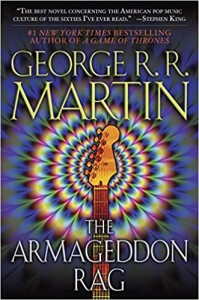 Well, I got involved in it almost by happenstance. Phillip de Guerre, who was the Executive Producer of The Twilight Zone, is also a big rock ‘n’ roll fan, and a number of years ago I did a book called The Armageddon Rag and Phil optioned it. At that time he flew me out to Hollywood, I had a number of meetings with him to discuss the screenplay he planned to write for The Armageddon Rag film, and he did write several screenplays but we never succeeded in getting the movie made, or financed. – George R. R. Martin
Well, I got involved in it almost by happenstance. Phillip de Guerre, who was the Executive Producer of The Twilight Zone, is also a big rock ‘n’ roll fan, and a number of years ago I did a book called The Armageddon Rag and Phil optioned it. At that time he flew me out to Hollywood, I had a number of meetings with him to discuss the screenplay he planned to write for The Armageddon Rag film, and he did write several screenplays but we never succeeded in getting the movie made, or financed. – George R. R. Martin
Sometimes the best films are never made. Like The War for The Oaks, The Armageddon Rag would have made one hell of a great film as it has sex, drugs, violence, true magic, and lots of music! Unlike The War for The Oaks, whose script I have read, I’ve never read the script for The Armageddon Rag, but I’d love to.
The place names are straight out of rock ‘n’ roll legend: Woodstock, Altamont, Monterey, West Mesa … West Mesa? Yes, West Mesa. It’s the 20th of September 1971. The Nazgul, a rock ‘n’ roll group of the ’60s, are performing on West Mesa near Albuquerque in front of 60,000 fans when a high-powered rifle bullet rips out the life of Patrick Henry “Hobbit” Hobbins Nazgul’s lead singer. He dies gruesomely, and the ’60s die with him. (Think Altamont with an even less happy ending.) The killer is never found and Nazgul breaks up, but their final album, Music To Wake the Dead, is released just after Hobbins’ death. (It helps to know, as you surely do, that the Nine Nazgul, or Ringwraiths, were the most terrifying servants of Sauron in J. R. R. Tolkien’s The Lord of the Rings trilogy.) The Armageddon Rag actually begins a decade or so later, and the three still living Nazgul have long since sunk into their separate mundane exsistences. But a grisly — very grisly — murder occurs when their former manager is, ahem, proved to have a heart after all.
Sandy Blair, aging ex-hippie gone straight and no longer a reporter for Hedgehog magazine, which fired him when the new publisher took over, is asked to write an article on the aforementioned bizarre sacrificial murder. Blair’s writing career is clearly not going well, and his live-in lover, who’s a real estate agent, can’t stomach his unceasing nostalgia for the ’60s. Against his better judgement, he agrees to write the article provided he can tell the full tale of the Nazgul. The mysteries that he uncovers connect Lynch’s death to the Nazgul and to the man who is now trying to effect the group’s comeback. Sandy’s search for explanations leads him across the continent into the remnants of the ’60s, and closer than he wants to someone who wants to revive the Nazgul whatever the cost. Indeed, the Music To Wake the Dead album and the resurrected Nazgul will prove to be the key to something horrific.
Rock ‘n’ roll music from the Rolling Stones to Janis Joplin and Jimi Hendrix infuses the book as it pervaded that tragic period in American history. The author’s use of lyrics from real songs of the ’60s as chapter headings emphatically conveys a chillingly accurate sense of the ’60s, and the music credits in fact run for two pages in the hardcover edition. Martin’s descriptions of the Nazgul’s performances, and his original lyrics for such Nazgul albums as Hot Wind Out Of Mordor and Music To Wake the Dead, are quite realistic. Martin’s attention to detail, including descriptions of the t-shirts sold at Nazgul concerts, adds authenticity to the story in a way that allows the reader to feel that Nazgul actually existed.
I won’t spoil your enjoyment of this book by detailing the plot beyond what I wrote above. It’s a mystery wrapped in a fantasy with believable elements of the music biz — I found it to be a bloody good read! And it’s worth seeking the hardcover edition as it’s a wonderfully nice package.
(Poseidon Press, 1983; Spectra, 2007)
